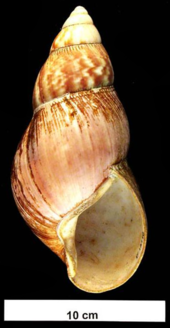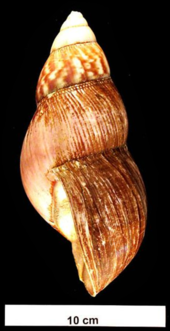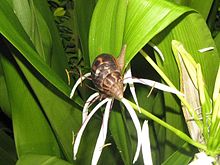Lissachatina fulica
| Lissachatina fulica | |
|---|---|

| |
| in Ubud, Bali | |
| Scientific classification | |
| Kingdom: | |
| Phylum: | |
| Class: | |
| (unranked): | clade Heterobranchia
clade Euthyneura clade Panpulmonata clade Eupulmonata clade Stylommatophora informal group Sigmurethra |
| Superfamily: | |
| Family: | |
| Subfamily: | |
| Genus: | |
| Subgenus: | |
| Species: | A. fulica
|
| Binomial name | |
| Achatina fulica (Férussac, 1821)
| |
Achatina fulica is a species of large land snail that belong in the Achatinidae family. It is also famously known as the giant African snail or giant African land snail.[1] This snail species has been considered a significant cause in pest issues around the world. Internationally, it is the most frequently occurring type of snail invasive species.[2]
Outside of its native range this snail thrives in many types of habitat in areas with mild climates. It feeds voraciously and is a vector for plant pathogens, causing severe damage to agricultural crops and native plants. It competes with native snail taxa, is a nuisance pest of urban areas, and spreads human disease.[1] This snail is listed as one of the top 100 invasive species in the world.[3]
Subspecies
Subspecies within this species:
- Achatina fulica hamillei Petit, 1859[4]
- Achatina fulica rodatzi Dunker, 1852
- Achatina fulica sinistrosa Grateloup, 1840
- Achatina fulica umbilicata Nevill, 1879
Distribution
The species is native to East Africa,[4] but it has been widely introduced to other parts of the world through the pet trade, as a food resource, and by accidental introduction.
This species has been found in China since 1931 (map of distribution in 2007), and its initial point of distribution in China was Xiamen.[5] The snail has also been established in the Pratas Islands, of Taiwan,[6] throughout India, the Pacific, Indian Ocean islands, and the West Indies. The species was established in the United States in 1936. They were brought to the U. S. through imports. They were intended to be used for educational uses and to be pets. Some were also introduced because they were accidentally shipped with other cargo.[7] Eradication is currently underway in Florida.[8]
The species has recently been observed in Bhutan (Gyelposhing, Mongar), where it is an invasive species. It has begun to attack agricultural fields and flower gardens. It is believed there that dogs have died as a result of consuming the snail.
Description
The adult snail is around 7 centimetres (2.8 in) in height and 20 centimetres (7.9 in) or more in length.
The shell has a conical shape, being about twice as high as it is broad. Either clockwise (dextral) or counter-clockwise (sinistral) directions can be observed in the coiling of the shell, although the right-handed (dextral) cone is the more common. Shell colouration is highly variable, and dependent on diet. Typically, brown is the predominant colour and the shell is banded.[9] The shell is particularly tough and has the highest heavy metal content of any snail species.[10]
 |
 |
 |
-
Adult shell size range
-
Adult and juvenile
-
Three shells of increasing maturity
Ecology
Habitat
The giant African snail is native to East Africa, and can be traced back to Kenya and Tanzania. It is a highly invasive species, and colonies can be formed from a single gravid individual. In many places, release into the wild is illegal. Nonetheless, the species has established itself in some temperate climates and its habitat now includes most regions of the humid tropics, including many Pacific islands, southern and eastern Asia, and the Caribbean. The giant snail can now be found in agricultural areas, coastland, natural forest, planted forests, riparian zones, scrub and shrublands, urban areas, and wetlands.
Feeding

The giant African snail is a macrophytophagous herbivore; it eats a wide range of plant material, fruit, and vegetables. It will sometimes eat sand, very small stones, bones from carcasses and even concrete as calcium sources for its shell. In rare instances the snails will consume each other.
In captivity, this species can be fed on a wide range of fruit and vegetables, plain unseasoned mince or boiled egg can be fed occasionally Cuttle Fish bone is commonly used as a calcium source for healthy shell growth. It requires about 18.28% of crude protein in its diet for optimal growth.[11]
Life cycle
This species is a simultaneous hermaphrodite; each individual has both testes and ovaries and is capable of producing both sperm and ova. Instances of self-fertilization are rare, occurring only in small populations. Although both snails in a mating pair can simultaneously transfer gametes to each other (bilateral mating), this is dependent on the size difference between the partners. Snails of similar size will reproduce in this way. Two snails of differing sizes will mate unilaterally (one way), with the larger individual acting as a female. This is due to the comparative resource investment associated with the different genders.[citation needed]
Like other land snails, these have intriguing mating behaviour, including petting their heads and front parts against each other. Courtship can last up to half an hour, and the actual transfer of gametes can last for two hours. Transferred sperm can be stored within the body for up to two years. The number of eggs per clutch averages around 200. A snail may lay five to six clutches per year with a hatching viability of about 90%.
Adult size is reached in about six months, after which growth slows, but does not cease until death. Life expectancy is commonly five or six years in captivity, but the snails can live for up to ten years. They are active at night and spend the day buried underground.
 |
 |
 |
The giant African snail is capable of aestivating for up to three years in times of extreme drought, sealing itself into its shell by secretion of a calcerous compound that dries on contact with the air.
Parasites
Parasites of Achatina fulica include:
- Aelurostrongylus abstrusus[12]
- Angiostrongylus cantonensis — causes eosinophilic meningoencephalitis[12]
- Angiostrongylus costaricensis — causes abdominal angiostrongyliasis[12]
- Schistosoma mansoni — causes schistosomiasis, detected in faeces[13]
- Trichuris spp. — detected in faeces[13]
- Hymenolepis spp. — detected in faeces[13]
- Strongyloides spp. — detected in faeces and in mucous secretion[13]
As an invasive species
In many places this snail is a pest of agriculture and households with the ability to transmit both human and plant pathogens. Suggested preventive measures include strict quarantine to prevent introduction and further spread. This snail has been given top national quarantine significance in the United States.[14] In the past, quarantine officials have been able to successfully intercept and eradicate incipient invasions on the mainland USA.[15]
In the wild, this species often harbors the parasitic nematode Angiostrongylus cantonensis, which can cause a very serious meningitis in humans. Human cases of this meningitis usually result from a person having eaten the raw or undercooked snail, but even handling live wild snails of this species can infect a person with the nematode and thus cause a life-threatening infection.[16]
In some regions, an effort has been made to promote use of the giant African snail as a food resource in order to reduce its populations. However, promoting a pest in this way is a controversial measure, because it may encourage the further deliberate spread of the snails.
One particularly catastrophic attempt to biologically control this species occurred on South Pacific Islands. Colonies of A. fulica were introduced as a food reserve for the American military during World War II and they escaped. A carnivorous species (Florida rosy wolfsnail, Euglandina rosea) was later introduced by the United States government, in an attempt to control A. fulica but the rosy wolf snail instead heavily preyed upon the native Partula, causing the extinction of most Partula species within a decade.
Human use
Achatina fulica are used by some practitioners of Candomblé for religious purposes in Brazil as an offering to the deity Oxalá. The snails substitute for a closely related species, the African giant snail (Archachatina marginata) normally offered in Nigeria. The two species share a common name (Ìgbín, also known as ibi or boi-de-oxalá in Brazil), and are similar enough in appearance to satisfy religious authorities.[17] They are also edible if cooked properly. The snails have also become increasingly popular as pets, with A. fulica one of the most common snails being sold in the pet trade[citation needed]. In Taiwan, this species is used in the dish of 炒螺肉(Hot Frying snails)which is a delicacy among the traditional drinking snacks. Achatina fulica constitutes the predominant land snail found in Chinese markets.[18]
The heparinoid acharan sulfate is isolated from this species.[19]
References
This article incorporates CC BY-2.0 text from the reference.[17]
- ^ a b Achatina fulica. Global Invasive Species Database. ISSG. IUCN.
- ^ Thiengo, Silvania (September 21, 2006). "Rapid spread of invasive snail in South America: the giant African snail, Achatina fulcia, in Brasil" (PDF). Biological Invasions.
- ^ View 100 of the World's Worst Invasive Alien Species. Global Invasive Species Database. ISSG. IUCN.
- ^ a b Rowson, B.; Warren, B.; Ngereza, C. (2010). "Terrestrial molluscs of Pemba Island, Zanzibar, Tanzania, and its status as an "oceanic" island". ZooKeys. 70: 1–39. doi:10.3897/zookeys.70.762.
{{cite journal}}: CS1 maint: unflagged free DOI (link) - ^ Lv, S.; Zhang, Y.; Liu, H. X.; Hu, L.; Yang, K.; Steinmann, P.; Chen, Z.; Wang, L. Y.; Utzinger, J. R.; Zhou, X. N. (2009). Knight, Matty (ed.). "Invasive Snails and an Emerging Infectious Disease: Results from the First National Survey on Angiostrongylus cantonensis in China". PLoS Neglected Tropical Diseases. 3 (2): e368. doi:10.1371/journal.pntd.0000368. PMC 2631131. PMID 19190771.
{{cite journal}}: CS1 maint: unflagged free DOI (link) figure 5. - ^ Wu S.-P., Hwang C.-C., Huang H.-M., Chang H.-W., Lin Y.-S. & Lee P.-F. (2007). "Land Molluscan Fauna of the Dongsha Island with Twenty New Recorded Species". Taiwania 52(2): 145-151. PDF Archived 2011-07-18 at the Wayback Machine.
- ^ "National Agriculture Library". National Invasive Species Information Center. March 17, 2016. Retrieved April 25, 2016.
- ^ Campo-Flores, Arian. October 4th, 2011. "Giant Alien Snails Attack Miami, Though They're Not in Much of a Rush: Eradication Teams Go House to House, Nabbing 10,000 Invaders; 'Crunch Under Our Feet'." Wall Street Journal. Link
- ^ Skelley, PE; Dixon, WN; and Hodges, G. 2011. Giant African land snail and giant South American snails: field recognition. Florida Department of Agriculture and Consumer Services. Gainesville, Florida. PDF[permanent dead link]
- ^ Jatto, Ejeomo.Osazuwa (2013). "Kinetic Studies Of Wastewater Treatment From Rubber Factory Using Snail Shell" (PDF). Journal Article. New York Science Journal. pp. 25–33. Retrieved 1 October 2014.
- ^ Template:Pt icon Soares C. M., Hayashi C., Gonçalves G. S., Nagae M. Y. & Boscolo W. R. (1999). "Exigência de proteína para o caracol gigante (Achatina fulica) em fase de crescimento. Protein requirements for giant snail (Achatina fulica) during the growth phase". Acta Scientiarum. Animal Sciences 21(3): 683-686. abstract, PDF.
- ^ a b c Ohlweiler, F. P.; Guimarães, M. C. D. A.; Takahashi, F. Y.; Eduardo, J. M. (2010). "Current distribution of Achatina fulica, in the State of São Paulo including records of Aelurostrongylus abstrusus (Nematoda) larvae infestation". Revista do Instituto de Medicina Tropical de São Paulo. 52 (4): 211–214. doi:10.1590/S0036-46652010000400009. PDF.
- ^ a b c d Template:Es icon Libora M., Morales G., Carmen S., Isbelia S. & Luz A. P. (2010). "Primer hallazgo en Venezuela de huevos de Schistosoma mansoni y de otros helmintos de interés en salud pública, presentes en heces y secreción mucosa del molusco terrestre Achatina fulica (Bowdich, 1822). [First finding in Venezuela of Schistosoma mansoni eggs and other helminths of interest in public health found in faeces and mucous secretion of the mollusc Achatina fulica (Bowdich, 1822)]. Zootecnia Tropical 28: 383-394. PDF[permanent dead link].
- ^ Cowie, R. H.; Dillon, R. T.; Robinson, D. G.; Smith, J. W. (2009). "Alien non-marine snails and slugs of priority quarantine importance in the United States: A preliminary risk assessment" (PDF). American Malacological Bulletin. 27: 113–132. doi:10.4003/006.027.0210.
- ^ "PBS "Alien Invasion". Accessed on 6 January 2008". Retrieved 7 October 2014.
- ^ "African snail: Deadly invasion in South America". BBC News. Retrieved 7 October 2014.
- ^ a b Léo Neto, N. A.; Brooks, S. E.; Alves, R. M. R. (2009). "From Eshu to Obatala: Animals used in sacrificial rituals at Candomblé "terreiros" in Brazil". Journal of Ethnobiology and Ethnomedicine. 5: 23. doi:10.1186/1746-4269-5-23. PMC 2739163. PMID 19709402.
{{cite journal}}: CS1 maint: unflagged free DOI (link) - ^ Lv, S.; Zhang, Y.; Steinmann, P.; Zhou, X.-N. (2008). "Emerging angiostrongyliasis in mainland China". Emerging Infectious Diseases. 14 (1): 161–164. doi:10.3201/eid1401.061529.
- ^ Gunay, NS; Linhardt, RJ (1999). "Heparinoids: structure, biological activities and therapeutic applications". Planta Med. 65: 301–6. doi:10.1055/s-1999-13990. PMID 10364832.
External links
- "Achatina fulica". National Center for Biotechnology Information (NCBI).
- Kerosene to combat African snails in Kerala
- United States Department of Agriculture New Pest Response Guidelines for Achatina fulica PDF
- Global Invasive Species Database
- Achatina fulica references from the Hawaiian Ecosystems at Risk project (HEAR)
- Slow-moving fast food
- Species Profile- Giant African Snail (Achatina fulica), National Invasive Species Information Center, United States National Agricultural Library. Lists general information and resources for Giant African Snail.
- Albuquerque, F. S.; Peso-Aguiar, M. C.; Assunção-Albuquerque, M. J.; Gálvez, L. (2009). "Do climate variables and human density affect Achatina fulica (Bowditch) (Gastropoda: Pulmonata) shell length, total weight and condition factor?". Brazilian journal of biology = Revista brasleira de biologia. 69 (3): 879–885. doi:10.1590/S1519-69842009000400016. PMID 19802448.
- Mead, Albert R. 1961. The Giant African Snail: A Problem in Economic Malacology. Univ. Chicago Press, 257 pp. (also available online)
- Invasive species
- List of introduced species



